The Greek god Hephaestus was a famed blacksmith, renowned for the skill of metallurgy. Markedly the only conventionally unattractive of all the Greek gods and goddesses, Hephaestus suffered in life from a multitude of physical and emotional ailments.
Hephaestus with his tragic character was arguably the most human-like of the Greek gods. He fell from grace, returned, and established himself in the pantheon through his talent and cunning. Impressively, the volcano god maintained a physically demanding job despite his physical disabilities, and he had managed to create cordial relationships with most of the gods that once snubbed him.
Moreso, as a patron of the arts alongside Athena, Hephaestus was fervently admired by humans and Immortals alike. No: he wasn’t at all agreeable like his female counterpart, having adopted much of his mother’s reputed temper, but he was a great craftsman.
Table of Contents
What Was Hephaestus the God Of?
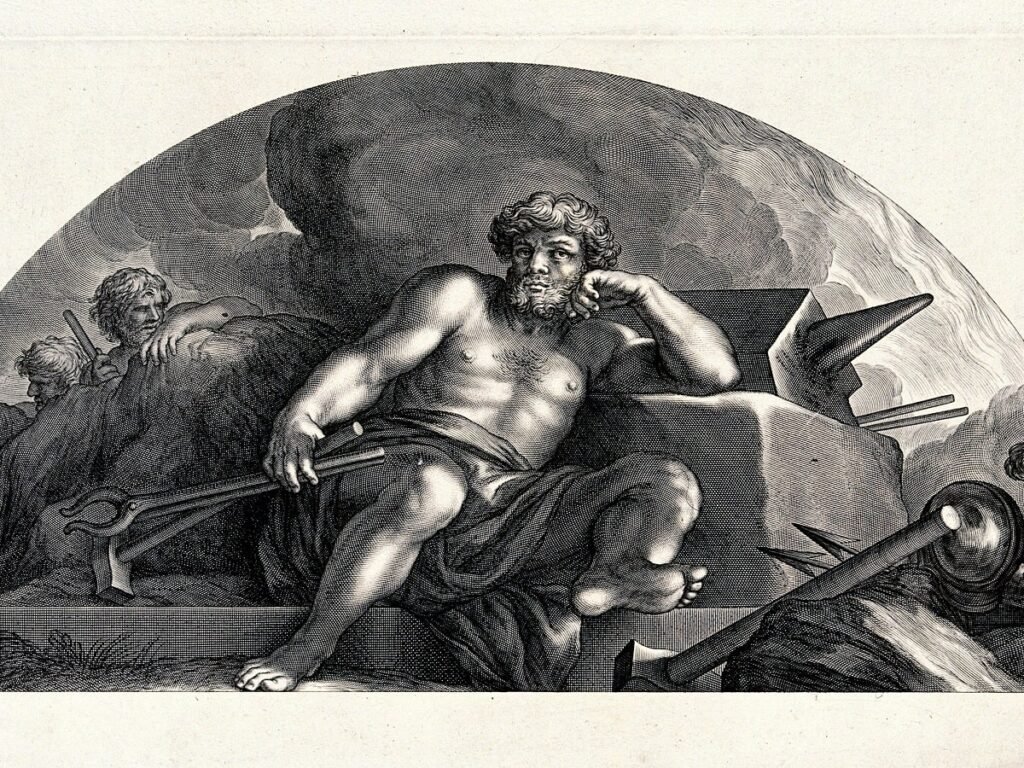
In the ancient Greek religion, Hephaestus was regarded as the god of fire, volcanoes, smiths, and craftsmen. Due to his patronage of the crafts, Hephaestus was closely affiliated with the goddess Athena.
Further, as a master smithing god, Hephaestus naturally had forges across the Greek world. His most prominent one lay within his very own palace on Mount Olympus, the home of the 12 Olympian Gods, where he would create divine weapons, impenetrable armor, and luxurious gifts for other Greek gods and goddesses and their chosen champions.
READ MORE: The Greek God Family Tree: A Complete Family Tree of All Greek Deities
Otherwise, records suggest that Hephaestus also had a forge on Lemnos – the location of his cult center – and in Lipara: one of many volcanic islands he is said to frequent.
What are Some Symbols of Hephaestus?
The symbols of Hephaestus revolve around his role as a craftsman and, more specifically, a smith. The hammer, anvil, and tongs – three primary symbols of Hephaestus – are all tools that a blacksmith and metalsmith would use in their daily life. They solidify the god’s relationship with metalworkers.
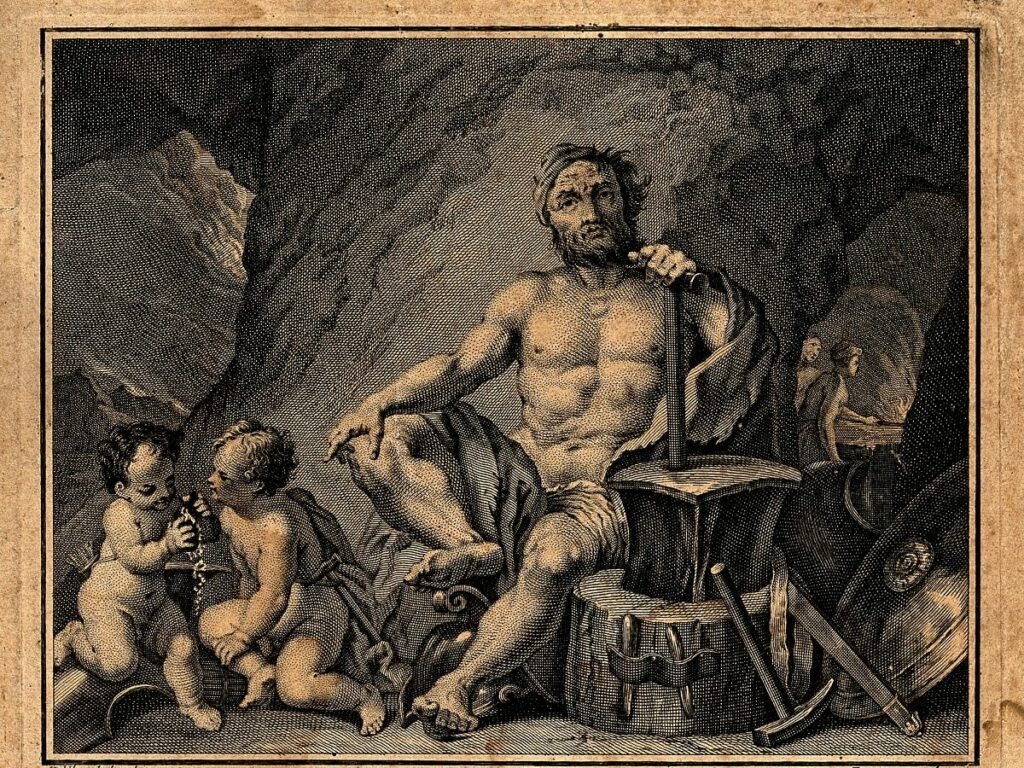
What are Some Epithets for Hephaestus?
When looking at some of his epithets, poets generally allude to Hephaestus’ deviant appearance or his respected occupation of a forge god.
Hephaestus Kyllopodíōn
Meaning “of dragging feet,” this epithet directly refers to one of Hephaestus’ possible disabilities. He is believed to have had a clubbed foot – or, in some accounts, feet – that required him to walk with the help of a cane.
Hephaestus Aitnaîos
Hephaestus Aitnaîos points to the location of one of Hephaestus’ purported workshops underneath Mount Etna.
Hephaestus Aithaloeis Theos
The translation of Aithaloeis Theos means “sooty god,” relating back to his work as a blacksmith and as a fire god where contact with soot would be inevitable.
How was Hephaestus Born?
Hephaestus didn’t exactly have the ideal birth. Honestly, it was quite unique when compared to the births of the other gods. He didn’t come out fully grown and ready to tackle the world like Athena; nor was Hephaestus an infant coddled in a godly crib.
The most commonly recorded birth story is that Hera, while in a spiteful mood over Zeus’ solo bearing of Athena, prayed to the Titans for a child greater than her husband. She became pregnant, and soon Hera gave birth to the infant Hephaestus.
This is all well and good, right? A prayer answered, a baby born, and a happy Hera! But, watch out: things take a turn here.
When the goddess saw how ugly her child was, she spared no time in literally throwing him from the Heavens. This indicated the beginning of Hephaestus’ exile from Olympus and the disdain he had towards Hera.
Other variations have Hephaestus being the natural-born son of Zeus and Hera, which makes his second exile burn twice as much.
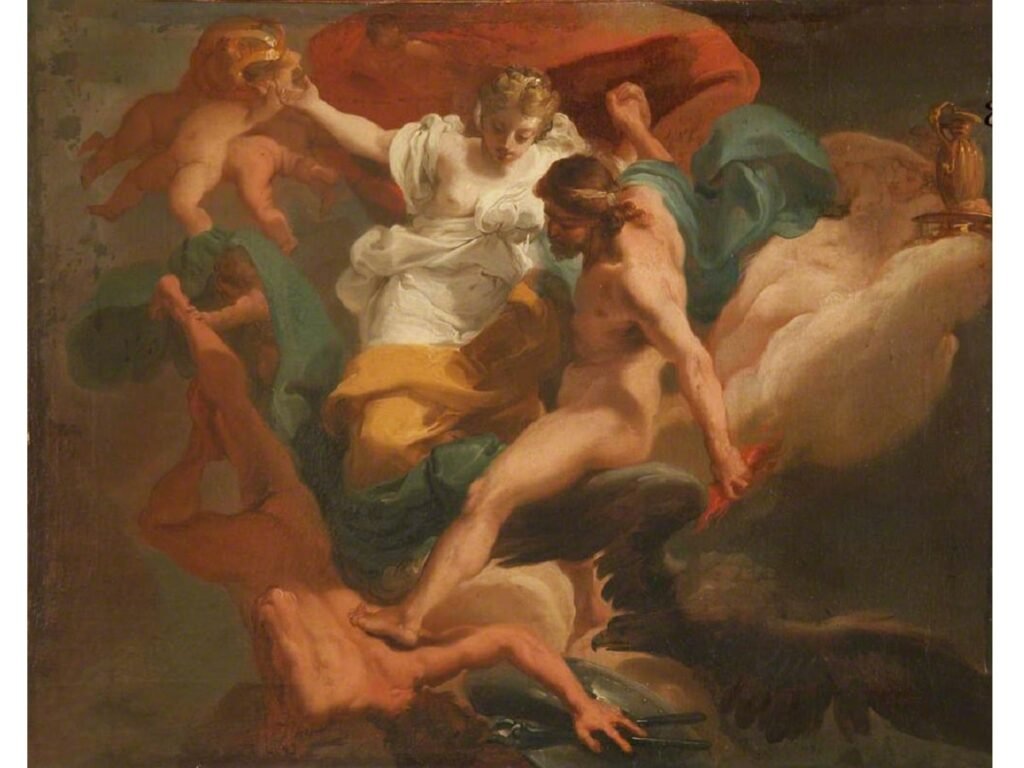
Living in Exile and Lemnos
Immediately following the tale of Hera throwing out her child, Hephaestus fell for several days before he landed in the sea and was raised by ocean nymphs. These nymphs – Thetis, the would-be mother of Achilles, and Eurynome, one of the famed Oceanid daughters of Oceanus, an important Greek water god, not to be confused with Poseidon and Tethys – stashed young Hephaestus away in an underwater cave where he honed his craft.
Contrarily, Zeus cast Hephaestus from Mount Olympus after he took Hera’s side in a disagreement. The accusedly ugly god fell for an entire day before landing on the island of Lemnos. There, he was taken in by the Sintians – an archaic group of Indo-European speaking peoples, recorded also as the Thracians – who inhabited Lemnos and the surrounding regions.
READ MORE: Zeus Family Tree: The Family Tree of the King of the Gods
The Sintians helped expand Hephaestus’ repertoire in metallurgy. While on Lemnos he mated with the nymph Caberio and fathered the mysterious Cabeiri: two metalworking gods of Phrygian origin.
Return to Olympus
A few years after Hephaestus’ initial exile from the Heavens, he made a plan to take revenge against his mother, Hera.
As the story goes, Hephaestus built a golden chair with quick, invisible binds and sent it to Olympus. When Hera took a seat, she was trapped. Not a single one of the gods was able to break her out of the throne, and they realized that Hephaestus was the only one able to free her.
Gods were sent to Hephaestus’ abode, but were all met with a single, stubborn retort: “I don’t have a mother.”
Realizing the young god’s resistance, the Council of Olympus selected Ares to threaten Hephaestus into returning; only, Ares was scared off by a rancorous Hephaestus wielding firebrands. The gods then elected Dionysus – kind and conversational – to bring the god of fire back to Olympus. Hephaestus, although holding his suspicions, drank with Dionysus. The two gods had a good enough time that Hephaestus completely let his guard down.
READ MORE: Dionysus Family Tree: The Lineage of the Greek God of Wine
Successful now in his mission, Dionysus ferried a very drunk Hephaestus to Mount Olympus on the back of a mule. Once back in Olympus, Hephaestus freed Hera, and the two reconciled. In turn, the Olympian gods made Hephaestus their honorary smith.
Otherwise in Greek mythology, his return from his second exile merely happened once Zeus decided to forgive him.

Why Was Hephaestus Crippled?
Hephaestus was believed to have either had a physical deformation present at birth or had been seriously crippled from one (or both) of his falls. So, the “why” really depends on which variation of Hephaestus’ story you are more inclined to believe. Regardless, the falls from Mount Olympus caused undeniably severe physical damage to Hephaestus as well as some psychological trauma.
How is Hephaestus Featured in Greek Mythology?
More often than not, Hephaestus plays a supportive role in myths. He, after all, is a humble craftsman – sort of.
This Greek god takes commissions from others in the pantheon more often than not. In the past, Hephaestus crafted righteous armaments for Hermes, like his winged helmet and sandals, and armor for the hero Achilles to use during the events of the Trojan War.
The Birth of Athena
In the instance of Hephaestus being one of the children born between Zeus and Hera, he was actually present at Athena’s birth.
So, one day Zeus was complaining about the worst headache he had ever experienced. It was excruciating enough that his screams could be heard around the entire world. Hearing their father in such severe pain, Hermes and Hephaestus rushed over.
Somehow, Hermes came to the conclusion that Zeus needed his head cracked open – why everyone blindly trusts the god prone to troublemaking and pranks on this matter is worth questioning, but we digress.
Upon Hermes’ direction, Hephaestus split Zeus’ skull open with his ax, freeing Athena from her father’s head.
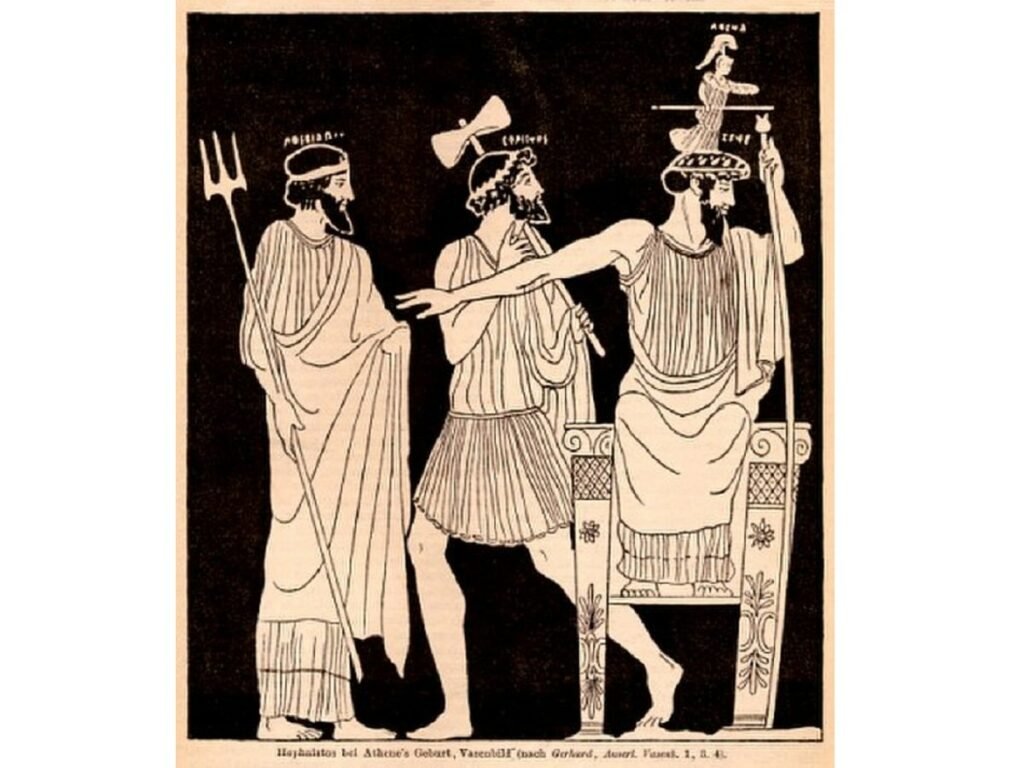
Hephaestus and Aphrodite
After her birth, Aphrodite was a hot commodity. She was not only a goddess new to town, but she set a new standard for beauty.
That’s right: Hera, in all her cow-eyed beauty, had some serious competition.
To avoid any squabbles amongst the gods – and probably to give Hera some type of assurance – Zeus married Aphrodite off as quickly as possible to Hephaestus, denying the goddess her only love, the moral Adonis. As one would guess, the marriage between the ugly god of metallurgy and the goddess of love and beauty didn’t go well. Aphrodite had shameless affairs, but none were as talked about as her long-lasting affections for Ares.
The Ares Affair
Suspicious that Aphrodite was seeing the god of war, Ares, Hephaestus created an unbreakable trap: a chain-link sheet so finely melded that it was rendered both invisible and lightweight. He set the trap above his bed, and in no time Aphrodite and Ares were entangled in more than just each other.
Taking advantage of their compromised state, Hephaestus calls upon the other Olympians. However, when Hephaestus goes to the gods of Mount Olympus for support, he gets an unexpected response. The other gods laughed at the display.
Alexandre Charles Guillemot notably captured the scene in his 1827 painting, Mars and Venus Surprised by Vulcan. The image captured is that of an exasperated husband, casting judgment towards his ashamed wife while the other gods looked on from afar – and her chosen lover? Gazing at the audience with an expression best described as peeved.
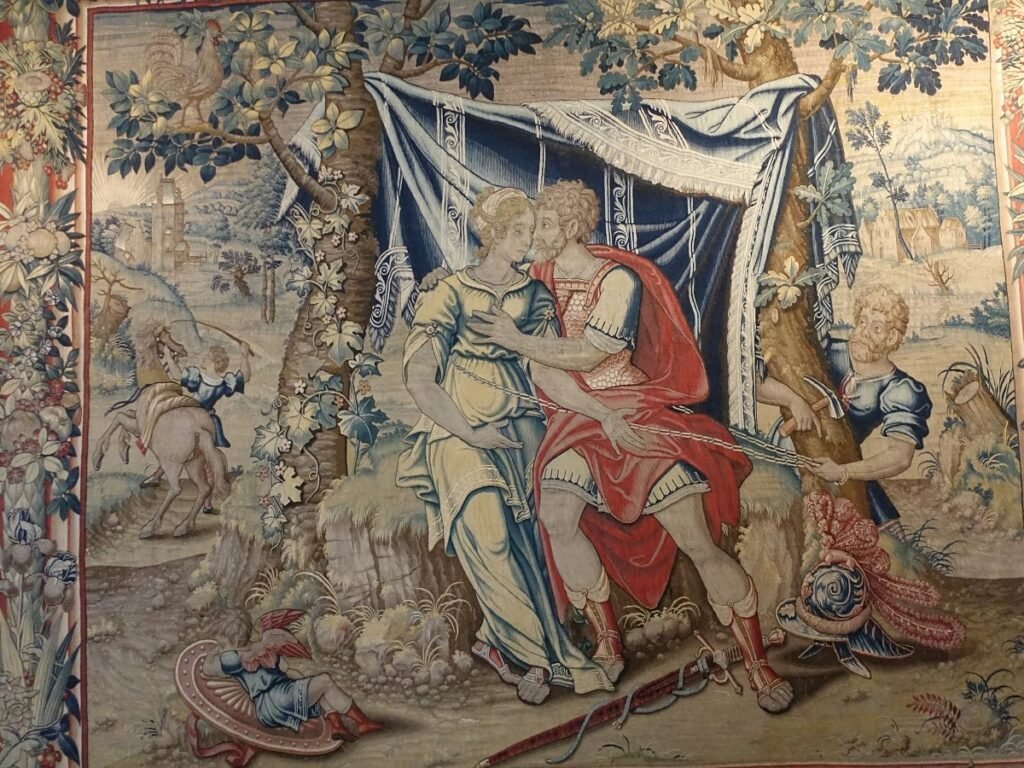
Famous Creations Made by Hephaestus
While Hephaestus made fine military equipment for the gods (and some demi-god heroes), he was no one trick pony! This god of fire made various other great works, including the following:
The Necklace of Harmonia
After getting sick and tired of walking in as Ares lay with his wife, Hephaestus vowed to seek revenge through the child born of their union. He bided time until their first child, a daughter named Harmonia, was getting married to Cadmus of Thebes.
He gifted Harmonia an exquisite robe and a luxurious necklace made by his own hand. Unknown to everyone, it was actually a cursed necklace and was to bring ill fortune to those that wore it. Coincidentally, as Harmonia was marrying into the Theban royal family, the necklace would play a revolving role in Thebes’ history until it was stowed away in the Temple of Athena at Delphi.
The Talos
Talos was a massive man made of bronze. Hephaestus, famous for his creation of automatons, crafted Talos as a gift to King Minos to protect the island of Crete. Legends say that Talos would hurl boulders at unwanted ships that got too close to Crete for his liking.
This impressive bronze creation eventually met his end at the hands of the magic practitioner Medea, who enchanted him to nick his ankle (the sole location where his blood was) on a sharp rock at the behest of the Argonauts.
READ MORE: Jason and the Argonauts: The Myth of the Golden Fleece
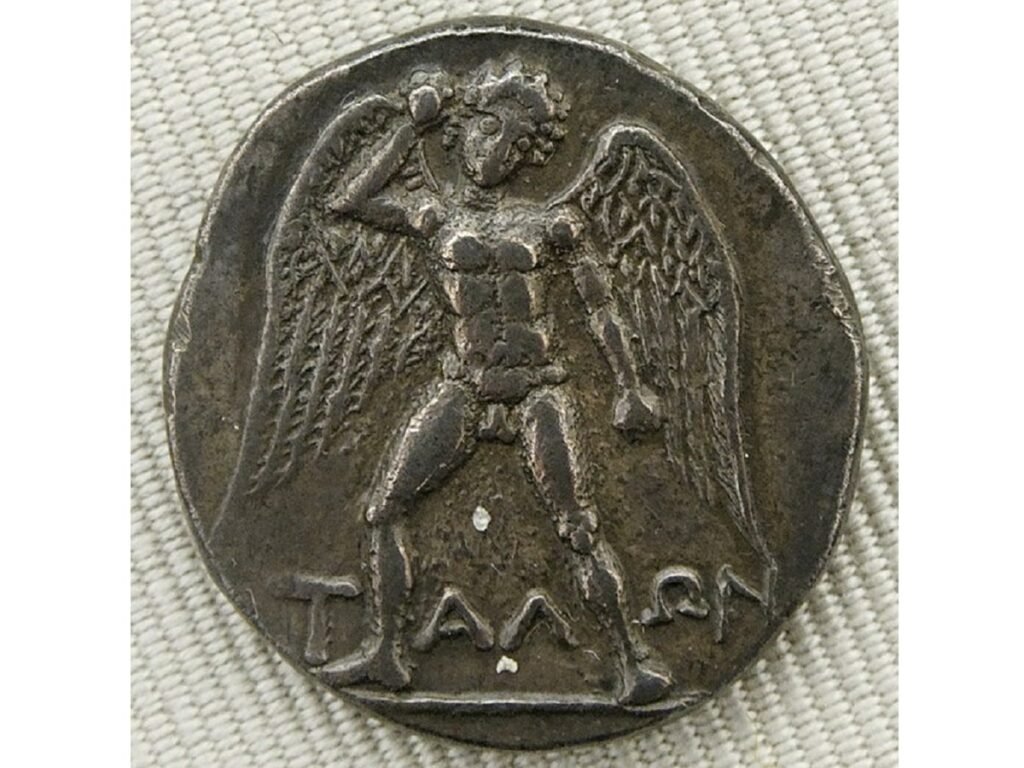
The First Woman
Pandora was the first human woman made by Hephaestus upon the instruction of Zeus. She was intended to be mankind’s punishment to balance their newfound power of fire directly following the Titan Prometheus myth.
First recorded in the poet Hesiod’s Theogony, the myth of Pandora wasn’t elaborated upon until his other collection, Works and Days. In the latter, the mischievous god Hermes had a large part in Pandora’s development as the other Olympian gods gave her other “gifts.”
The story of Pandora is largely considered by historians to be the ancient Greeks’ divine answer as to why evil exists in the world.
READ MORE: Pandora’s Box: The Myth Behind the Popular Idiom
The Cult of Hephaestus
The cult of Hephaestus was primarily established on the Greek island of Lemnos. On the island’s northern shore, an ancient capital city was dedicated to the god named Hephaestia. Near this once-flourishing capital was a center to collect the medicinal clay known as Lemnian Earth.
Greeks frequently used medicinal clay to combat injuries. As it so happens, this particular clay was said to possess great healing powers, much of which was attributed to the blessing of Hephaestus himself. Terra Lemnia, as it is also known, was said to cure madness and cure wounds inflicted by a water snake, or any wound that bled heavily.
READ MORE: Who Invented Water? History of the Water Molecule
Temple of Hephaestus at Athens
As a patron god of various artisans alongside Athena, it is unsurprising that Hephaestus had a temple established in Athens. In fact, the two have more history than just being two sides of the same coin.
In one myth, the city’s patron goddess, Athena, was engaged to Hephaestus. She tricked him, and vanished from the bridal bed, resulting in Hephaestus accidentally impregnating Gaia with Erichthonius, a future King of Athens. Once born, Athena does adopt Erichthonius as her own, and the deceit maintains her identity as a virgin goddess.
READ MORE: City Gods from Around the World
The two gods were also associated with Prometheus: another divine being related to fire, and the central character in the tragic play, Prometheus Bound. Prometheus himself did not have a popular cult, but he was occasionally worshiped alongside Athena and Hephaestus during select Athenian rituals.
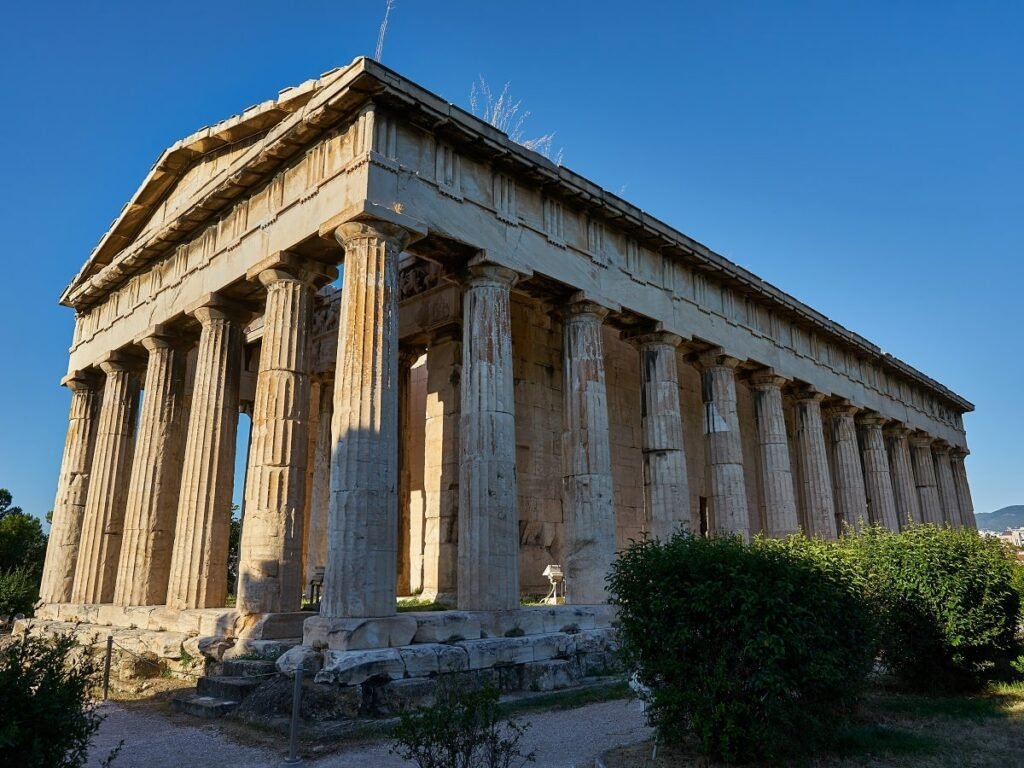
What is Hapheaestus Called in Roman Mythology?
Roman gods are oftentimes directly tied to Greek gods, with many of their key traits intact. When in Rome, Hephaestus was adapted as Vulcan.
Hephaestus’ specific cult likely spread to the Roman Empire during their Grecian expansion period around 146 BCE, although the worship of a god of fire known as Vulcan dates back to the 8th century BCE.
Hephaestus in Art
Art has been able to grant audiences from across the world the opportunity to get a glance into the personality of otherwise intangible beings. From classic literature to statues made by modern hands, Hephaestus is one of the most recognizable of the Greek gods.
Depictions commonly have Hephaestus appear as a stout, bearded man, with dark curls hidden beneath a felt pileus cap that was worn by artisans in ancient Greece. While he is shown to be muscular, the depth of his physical disability depends on the artist in question. Occasionally, Hephaestus is seen with a hunch or a cane, but most prominent works show the god of fire to be working over his latest project with smith tongs in hand.
In a general comparison to other male gods appearance’s, Hephaestus is notably shorter and with an unkept beard.
When referencing ancient Greek art from the Archaic (650 BCE – 480 BCE) and the Hellenistic Periods (507 BCE – 323 BCE), Hephaestus frequently appears on vases that depict the processional that heralded his first return to Mount Olympus. Other period works focus more on the god’s role in the forge, highlighting his dedication to his crafts.
Meanwhile, one of the more admired images of Hephaestus is Guillaume Coustou’s 1742 famous statue, Vulcan. The statue shows a man reclining on an anvil, a blacksmith’s hammer in hand as he supports himself atop an iconic Attic helmet. His round eyes are looking towards the sky. His nose is uniquely button-like. Here, Hephaestus – addressed as his Roman equivalent, Vulcan – appears to be relaxed; the audience catches him on a rare day off.